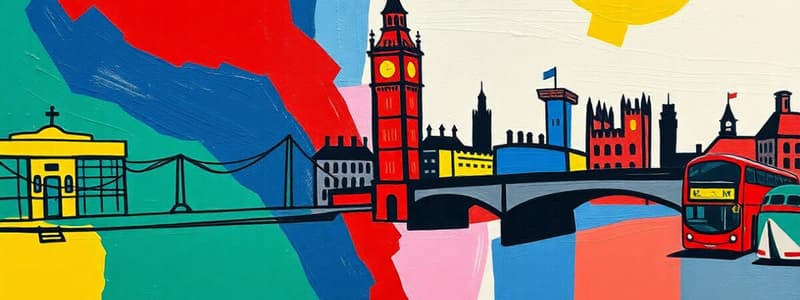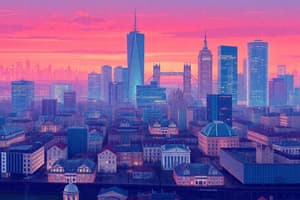Podcast
Questions and Answers
What kind of urban challenges are mentioned that affect residents?
What kind of urban challenges are mentioned that affect residents?
- High temperatures and drought
- Lack of recreational facilities
- High social mobility and job availability
- Pollution, congestion, and crime prevention (correct)
Which factor is noted as impacting social infrastructure and housing?
Which factor is noted as impacting social infrastructure and housing?
- High population density and property prices (correct)
- Economic wealth distribution
- Technological advancements
- Low transportation access
What ongoing concerns are local governments adapting to, according to the challenges listed?
What ongoing concerns are local governments adapting to, according to the challenges listed?
- Urban sprawl
- Population decline
- Climate change (correct)
- Increased tourism and economy
What is one of the initiatives underway to improve future conditions in the city?
What is one of the initiatives underway to improve future conditions in the city?
What is a key goal for the city’s ongoing planning and development efforts?
What is a key goal for the city’s ongoing planning and development efforts?
What is the area covered by London?
What is the area covered by London?
Which historical event marked the founding of London?
Which historical event marked the founding of London?
Which of the following best describes London's cultural identity?
Which of the following best describes London's cultural identity?
What is one of London's significant economic roles?
What is one of London's significant economic roles?
What is London's significance in UK politics?
What is London's significance in UK politics?
Which of the following is not a primary component of London's transport network?
Which of the following is not a primary component of London's transport network?
Which landmark is not considered one of London's iconic sites?
Which landmark is not considered one of London's iconic sites?
What is a defining feature of London's investment in industries?
What is a defining feature of London's investment in industries?
Flashcards
High Population Density Impact
High Population Density Impact
The negative effects of a large number of people living in a small area, resulting in limited resources and high costs.
Urban Challenges
Urban Challenges
Efforts to reduce pollution, traffic jams, and crime in urban areas.
Social Inequality
Social Inequality
Disparities among residents in terms of wealth, access to resources, and opportunities.
Public Safety and Security
Public Safety and Security
Signup and view all the flashcards
Adapting to Climate Change
Adapting to Climate Change
Signup and view all the flashcards
Where is London located?
Where is London located?
Signup and view all the flashcards
What is London's historical significance?
What is London's historical significance?
Signup and view all the flashcards
What cultural aspects make London unique?
What cultural aspects make London unique?
Signup and view all the flashcards
How does London impact the economy?
How does London impact the economy?
Signup and view all the flashcards
What is London's political significance?
What is London's political significance?
Signup and view all the flashcards
How does London's transportation system operate?
How does London's transportation system operate?
Signup and view all the flashcards
What are some of London's significant landmarks and attractions?
What are some of London's significant landmarks and attractions?
Signup and view all the flashcards
Study Notes
Geography and Location
- Situated in southeastern England, on the River Thames.
- Covers an area of approximately 1,572 square kilometers.
- Historically at a key point of travel and trade, thanks to its location on an estuary.
- Made up of 33 boroughs and several Royal Parks.
History
- Founded by the Romans, as Londinium.
- Played a central role in British history, with historical events shaping its character and development.
- Developed from a Roman settlement into a major medieval city and then a center for industry, commerce, and finance.
- Known for its significant historical monuments and events.
Culture and Identity
- Diverse population with individuals from various ethnic and cultural backgrounds.
- Famous for its museums, art galleries, theaters, and world-class entertainment venues.
- Strong emphasis on arts and culture, encompassing varied musical genres, visual arts, theatre productions, and more.
- Known for its global influence in entertainment and creative industries, as well as global tourism.
Economy
- Centralised role in the economy and major contributor to the UK economy.
- Major hub for international finance, commerce, and trade.
- Strong presence in the technology sector and global business and services industries.
- Significant historical and ongoing investment in the arts, cultural and creative industries.
Government and Politics
- Capital city of the United Kingdom, housing the central government.
- Historically central in political decisions and processes.
- Major influence on UK politics, and role as a global political hub.
- Significant presence of political activity and engagement from different groups and individuals.
Transport
- Extensive and complex public transport network: underground, bus, and train systems.
- Multiple significant airports (e.g. Heathrow) and maritime ports connect it globally.
- Important transport links are used and maintained for local and international purposes.
- Network of roads, allowing for easy travel in and around the city.
Notable Landmarks and Attractions
- Iconic landmarks, such as Buckingham Palace, the Houses of Parliament, and the Tower of London, attract millions of visitors annually.
- Other notable sites include the British Museum, the London Eye, and Hyde Park.
- Landmarks and attractions reflect London's deep history and cultural significance, as well as its development over time.
Challenges
- High population density and property prices affect residents, and pose challenges for social infrastructure and housing.
- Urban challenges including pollution, congestion, and crime prevention persist.
- Social inequality and societal issues can affect the well-being of residents.
- Maintaining public safety and security amid the global and local conditions and challenges.
Future
- Ongoing planning and development to improve and sustain the environment, infrastructure and services.
- Adaptations to the ongoing concerns related to climate change are addressed by the city and its local government.
- Sustainable practices and efforts are underway to ensure the city continues as a global hub maintaining and improving its reputation.
- Future projects and initiatives to address social inequalities are underway to promote a more equitable future for all.
Studying That Suits You
Use AI to generate personalized quizzes and flashcards to suit your learning preferences.




